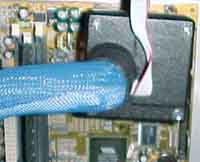Kryotech Cool K6-2 500
by Anand Lal Shimpi on December 23, 1998 8:11 PM EST- Posted in
- Cases/Cooling/PSUs
Removing the Problem
| Coming up from the base of the case is a fairly thick insulated blue tube leading up to the processor's enclosure. Both the tube and the enclosure are insulated, and even when the processor is running at -40 degrees Celsius you can't feel a thing through either component. The tube is the means of transportation for the gas in the refrigeration process, and the black casing ensures that there is no loss of the effectiveness of the cooling by isolating the processor as the only source of heat and the only component receiving the vapor phase refrigeration. |  |
| The after effects of this are two fold, first of all, the processor is cooled down to an incredibly cool temperature with the problems associated with condensation removed through the use of the aforementioned insulated tubing and the processor capsule, and secondly, without the incredible heat production of your CPU, the rest of your system receives the benefit of a lower ambient case temperature, allowing those hot SCSI drives and Voodoo2's to operate in a much cooler environment. |  |
Firing it Up & Measuring Performance
| The system requires that two power cables be connected, one for the main computer, one for the cooling system, so be sure to have enough open sockets where you place the system. Turning on the computer sounded much like turning on a fridge, the base of the system gave a quick shake and proceeded to cool down immediately. The LCD display at the front of the case steadily dropped from 23 degrees Celsius down to -36 in around a minute, upon hitting -36 the main system turned on and the FIC PA-2013's BIOS indicated an AMD K6-2 running at 506MHz during the power on self test. |  |
Needless to say, the stability of the system during the continuous usage tests AnandTech ran on Kryotech's Cool K6-2 500 was top notch, much greater than conventional air-cooled systems under Windows 98 and extremely reliable, something not possible when overclocking a normal K6-2 400 system to 500MHz. The temperature of the cooled system, according to Kryotech's LCD panel, varied from -40 degrees Celsius to -43 degrees, proving that their claims were well founded.
The performance of the 500MHz K6-2 system was approximately 5% faster than an overclocked 450MHz K6-2, and 6% slower than a K6-3 running at 350MHz. The performance under games wasn't a huge increase over the readily available 400MHz K6-2, and barely outperformed AnandTech's overclocked 450MHz K6-2.










0 Comments
View All Comments